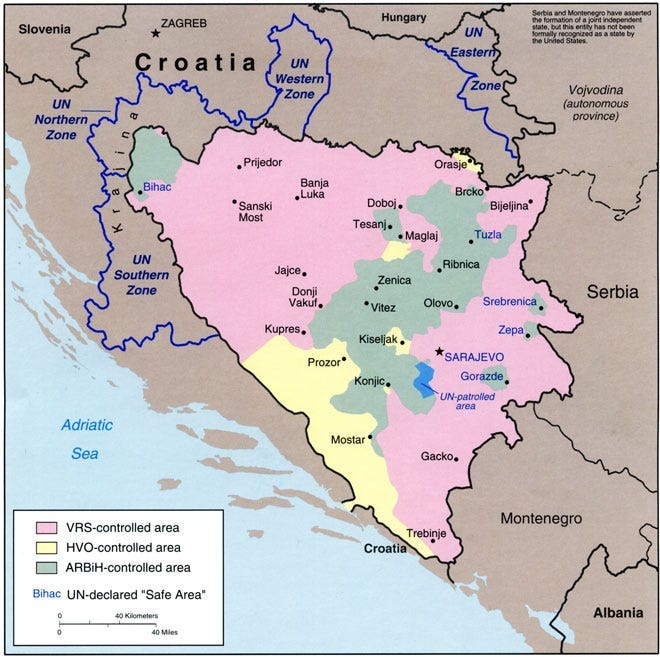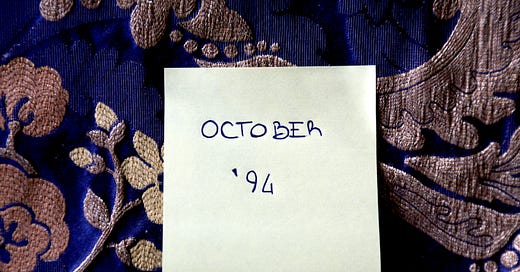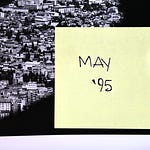October 1994.
Pope John Paul II’s inability to visit Sarajevo is followed by a renewed wave of violence on the Bosnian battlefield [you can listen to the latest episode of BarBalkans - Podcast here].
In Mostar, tensions flare up again between Bosnian-Croat ultranationalists and Bosniaks. In Sarajevo, the situation remains desperate due to the blockade of humanitarian convoys imposed by the Bosnian Serbs.
While the Serbian President Slobodan Milošević is working to persuade the international community to lift the sanctions against the Federal Republic of Yugoslavia, Republika Srpska experiences its most serious crisis.
Six more months of embargo
The Contact Group Plan for peace in Bosnia and Herzegovina is effectively dead, due to the result of the referendum in Republika Srpska held at the end of August.
Bosnian Serbs have until October 15 to respond to the peace plan. Anticipating a likely rejection, US President Bill Clinton has already promised to ask the UN Security Council to lift the international arms embargo on Bosnia and Herzegovina.
However, even before the official deadline expires, President Clinton himself suggests postponing the lifting of the embargo for another six months, to gain time for negotiating a peace solution.
The Security Council consequently renews UNPROFOR’s mandate in Bosnia and Herzegovina for another half a year (until the end of March 1995), to the satisfaction of officials in Moscow, Paris and London.
Contrary to expectations, Bosnian President Alija Izetbegović does not complain, because his government is secretly rearming the Bosnian military through the flow of smuggled weapons from Iran and Turkey. Since early summer, Sarajevo has been receiving around 2000 units of artillery, US Stinger anti-tank missiles and Chinese Red Arrow 8 anti-tank missiles every month.
At the beginning of October, everything is ready for the Bosniak counteroffensive, partly due to the disagreements between Belgrade and Pale that are fragmenting the Serbian front.

Converging attacks
The Bosnian army offensive begins from Sarajevo on October 3, when the Bosniak troops aim to capture the area around Mount Igman, and to open a passage to the enclaves in eastern Bosnia.
The goal is to capture strategic positions around the capital and cut off the supply lines of the Bosnian Serb forces led by Ratko Mladić.
This offensive out of Sarajevo is only the first in a series of military operations against the Bosnian Serb army, which gives the clear impression that the time has come for the Bosniaks’ comeback on the battlefield throughout the month of October.

The largest offensive is launched on October 22 from Bihać, an enclave recaptured by Bosnian forces between July and August, following the defeat of the Autonomous Region of Western Bosnia.
Expecting a Bosnian Serb attack on the enclave, the 5th Corps of the Bosnian Army led by General Atif Dudaković launches Operation Grmec-94, securing control of the strategically important Grabež highland in four days.
Positioned on the highland east of Bihać, during the last week of October, the 5th Army Corps recaptures 250 square kilometers of territory controlled by the Bosnian Serb army. The rail link between Banja Luka (the de facto capital of Republika Srpska, in Bosnia) and Knin (the capital of the Republic of Serbian Krajina, in Croatia) is threatened.
Moreover, after almost two years of truce, the Croatian Defence Council (the Bosnian Croat army) launches a surprise attack against the Bosnian Serb forces in the area around the town of Kupres, which was captured by Bosnian Serb forces in April 1992.
Halfway between Bihać and Mostar, the town of Kupres is a strategic location for controlling central Bosnia and western Herzegovina. Most importantly, it represents a possible new beginning of cooperation on the ground between the Bosniak and Bosnian-Croat armed forces.

The support of readers who every day gives strength to this project - reading and sharing our articles - is essential to realize all that you have read and listened to, and even more.
If you know someone who can be interested in The Yugoslav Wars podcast, why not give them a gift subscription?
Behind every original product comes an investment of time, energy and dedication. With your support BarBalkans will be able to elaborate new ideas, interviews and collaborations.
Here is the archive of The Yugoslav Wars:
Here you can find a summary of the past years:














Share this post